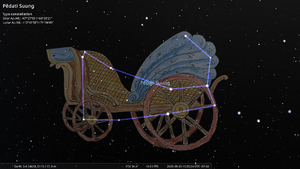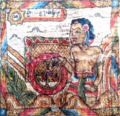Pedati Suung
Pědati Suung is an Oceanic name from Bali (Indonesia). The lintang of pědati suung is found in intersection of Coma (Monday, in saptawara) and Kliwon (in pancawara) in a series of palelintangan. Lintang pědati suung means an empty horse cart constellation.[1]
Etymology and History
Spelling Variants
- Pědati suhung
- Pědati suwung
- Pědati puyung
- Padati sunja
- pědati
Origin of Constellation
ii test ...
Transfer and Transformation of the Constellation
Mythology / Religion
Image Variants
Cultural Beliefs
Numerology (Neptu/Urip)
Coma (Monday, in saptawara) has a value of 4 and Kliwon (in pancawara) has a value of 8. Thus, the total urip on this lintang is 12.[2]
Astrological Characteristics
Often sacrifice, even though it sometimes makes him miserable, good at debating and processing words, thin-eared so that he is easily offended. However, they are sincere forgiving. He is often taken advantage of by others, his work only benefits others, but harms himself. His services are appreciated by few people, but later repaid by Hyang Widhi in his old age and happiness will be enjoyed in his old age from his descendants.[2]
Matching Gemstones
Rudirarnawa (garnet) dan Nila (Saphire).[2]
Weblinks
All HIP Stars within this constellation
HIP 41704, HIP 42434, HIP 43624, HIP 44127, HIP 44471, HIP 44504, HIP 44613, HIP 44717, HIP 44901, HIP 45333, HIP 45455, HIP 45493, HIP 45836, HIP 45915, HIP 46168, HIP 46733, HIP 46853, HIP 47006, HIP 47231, HIP 47521, HIP 47633, HIP 47664, HIP 47965, HIP 48319, HIP 48402, HIP 48638, HIP 48682, HIP 48802, HIP 49005, HIP 49363, HIP 49408, HIP 50222, HIP 50509, HIP 50606, HIP 50635, HIP 51814, HIP 52136, HIP 52478, HIP 52685, HIP 53043, HIP 53064, HIP 53157, HIP 53261, HIP 53706, HIP 53781, HIP 53798, HIP 53910, HIP 54061, HIP 54539, HIP 55086, HIP 55485, HIP 55797, HIP 56083, HIP 56120, HIP 56135, HIP 56510, HIP 56731, HIP 56944, HIP 57045, HIP 57399, HIP 57477, HIP 58001, HIP 58181, HIP 58225, HIP 59458, HIP 59774
References
- References (general)
- ↑ Maass, Alfred, “Astrologische Kalender der Balinesen,” in Koninklijk Bataviaasch Genootschap van Kunsten en Wetenschappen, Feestbundel bij gelegenheid van zijn 150 jarig bestaan 1778-1928, 2 vols. (Weltevreden, 1929), Vol. 2, 126-157.
- ↑ 2.0 2.1 2.2 Tim Kajian Palelintangan, “Gabungan Kajian Palelintangan,” Museum Bali (2021), 1-149.






